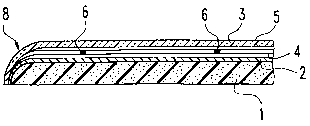Une partie des informations de ce site Web a été fournie par des sources externes. Le gouvernement du Canada n'assume aucune responsabilité concernant la précision, l'actualité ou la fiabilité des informations fournies par les sources externes. Les utilisateurs qui désirent employer cette information devraient consulter directement la source des informations. Le contenu fourni par les sources externes n'est pas assujetti aux exigences sur les langues officielles, la protection des renseignements personnels et l'accessibilité.
L'apparition de différences dans le texte et l'image des Revendications et de l'Abrégé dépend du moment auquel le document est publié. Les textes des Revendications et de l'Abrégé sont affichés :
| (12) Demande de brevet: | (11) CA 2194754 |
|---|---|
| (54) Titre français: | SUPPORT POUR SOURIS D'ORDINATEUR |
| (54) Titre anglais: | SUPPORT FOR COMPUTER MOUSE |
| Statut: | Réputée abandonnée et au-delà du délai pour le rétablissement - en attente de la réponse à l’avis de communication rejetée |
| (51) Classification internationale des brevets (CIB): |
|
|---|---|
| (72) Inventeurs : |
|
| (73) Titulaires : |
|
| (71) Demandeurs : |
|
| (74) Agent: | CASSAN MACLEAN |
| (74) Co-agent: | |
| (45) Délivré: | |
| (86) Date de dépôt PCT: | 1995-07-11 |
| (87) Mise à la disponibilité du public: | 1996-01-25 |
| Licence disponible: | S.O. |
| Cédé au domaine public: | S.O. |
| (25) Langue des documents déposés: | Anglais |
| Traité de coopération en matière de brevets (PCT): | Oui |
|---|---|
| (86) Numéro de la demande PCT: | PCT/EP1995/002690 |
| (87) Numéro de publication internationale PCT: | WO 1996002041 |
| (85) Entrée nationale: | 1997-01-09 |
| (30) Données de priorité de la demande: | ||||||
|---|---|---|---|---|---|---|
|
Un support pour souris d'ordinateur (tapis pour souris) comprend, disposée sur une feuille inférieure en mousse, au moins une mince couche colorée de liquide contenue entre deux feuilles positionnées sur la feuille inférieure et soudées l'une à l'autre par leurs bords de manière étanche aux liquides. La mince couche colorée de liquide est visible à travers les feuilles transparentes. Etant donné que le liquide ne remplit pas entièrement l'espace disponible, il se répartit constamment, formant des motifs à stries qui se modifient à chaque fois que l'on actionne la souris, ce qui donne un aspect optiquement intéressant au tapis pour souris.
A support for computer mouse (mouse pad) has at least one thin coloured liquid
layer arranged on a bottom foam plate and enclosed between two foils arranged
on the bottom plate and welded together in a liquid-tight manner at their
edges. The thin coloured liquid layer may be seen through the transparent
foils. Since the liquid does not completely fill the available space, it is
constantly redistributed, forming ever-changing streaked patterns every time
the mouse is actuated, and giving to the mouse pad an optically interesting
optical appearance.
Note : Les revendications sont présentées dans la langue officielle dans laquelle elles ont été soumises.
Note : Les descriptions sont présentées dans la langue officielle dans laquelle elles ont été soumises.

2024-08-01 : Dans le cadre de la transition vers les Brevets de nouvelle génération (BNG), la base de données sur les brevets canadiens (BDBC) contient désormais un Historique d'événement plus détaillé, qui reproduit le Journal des événements de notre nouvelle solution interne.
Veuillez noter que les événements débutant par « Inactive : » se réfèrent à des événements qui ne sont plus utilisés dans notre nouvelle solution interne.
Pour une meilleure compréhension de l'état de la demande ou brevet qui figure sur cette page, la rubrique Mise en garde , et les descriptions de Brevet , Historique d'événement , Taxes périodiques et Historique des paiements devraient être consultées.
| Description | Date |
|---|---|
| Inactive : CIB expirée | 2013-01-01 |
| Inactive : CIB désactivée | 2011-07-29 |
| Inactive : CIB dérivée en 1re pos. est < | 2006-03-12 |
| Inactive : CIB de MCD | 2006-03-12 |
| Le délai pour l'annulation est expiré | 2003-07-11 |
| Demande non rétablie avant l'échéance | 2003-07-11 |
| Inactive : Renseign. sur l'état - Complets dès date d'ent. journ. | 2002-09-27 |
| Inactive : Abandon.-RE+surtaxe impayées-Corr envoyée | 2002-07-11 |
| Réputée abandonnée - omission de répondre à un avis sur les taxes pour le maintien en état | 2002-07-11 |
| Lettre envoyée | 2001-03-15 |
| Inactive : Lettre officielle | 1999-11-04 |
| Inactive : Transferts multiples | 1999-10-14 |
| Demande publiée (accessible au public) | 1996-01-25 |
| Date d'abandonnement | Raison | Date de rétablissement |
|---|---|---|
| 2002-07-11 |
Le dernier paiement a été reçu le 2001-07-06
Avis : Si le paiement en totalité n'a pas été reçu au plus tard à la date indiquée, une taxe supplémentaire peut être imposée, soit une des taxes suivantes :
Veuillez vous référer à la page web des taxes sur les brevets de l'OPIC pour voir tous les montants actuels des taxes.
| Type de taxes | Anniversaire | Échéance | Date payée |
|---|---|---|---|
| TM (demande, 2e anniv.) - générale | 02 | 1997-07-11 | 1997-07-08 |
| TM (demande, 3e anniv.) - générale | 03 | 1998-07-13 | 1998-06-24 |
| TM (demande, 4e anniv.) - générale | 04 | 1999-07-12 | 1999-06-15 |
| Enregistrement d'un document | 1999-10-14 | ||
| TM (demande, 5e anniv.) - générale | 05 | 2000-07-11 | 2000-07-07 |
| TM (demande, 6e anniv.) - générale | 06 | 2001-07-11 | 2001-07-06 |
Les titulaires actuels et antérieures au dossier sont affichés en ordre alphabétique.
| Titulaires actuels au dossier |
|---|
| HIRSCH & PARTNER GMBH |
| Titulaires antérieures au dossier |
|---|
| KARL HIRSCH |